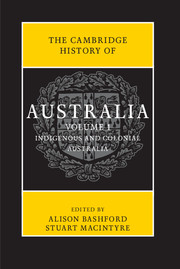Book contents
- Frontmatter
- Contents
- Abbreviations
- List of maps
- List of figures
- List of tables
- Notes on contributors
- Map
- Preface
- Introduction
- PART I
- PART II
- 11 Environmental transformations
- 12 Population and health
- 13 The economy
- 14 Indigenous and settler relations
- 15 Education
- 16 Law and regulation
- 17 Religion
- 18 Colonial science and technology
- 19 Gender and colonial society
- 20 Art and literature: a cosmopolitan culture
- 21 Empire: Australia and ‘Greater Britain’, 1788–1901
- 22 Colonial Australia and the Asia-Pacific region
- 23 The Australian colonies in a maritime world
- Further reading
- Chronology
- Index
- Frontmatter
- Contents
- Abbreviations
- List of maps
- List of figures
- List of tables
- Notes on contributors
- Map
- Preface
- Introduction
- PART I
- PART II
- Further reading
- Chronology
- Index
19 - Gender and colonial society
from PART II
Published online by Cambridge University Press: 05 November 2013
- Frontmatter
- Contents
- Abbreviations
- List of maps
- List of figures
- List of tables
- Notes on contributors
- Map
- Preface
- Introduction
- PART I
- PART II
- 11 Environmental transformations
- 12 Population and health
- 13 The economy
- 14 Indigenous and settler relations
- 15 Education
- 16 Law and regulation
- 17 Religion
- 18 Colonial science and technology
- 19 Gender and colonial society
- 20 Art and literature: a cosmopolitan culture
- 21 Empire: Australia and ‘Greater Britain’, 1788–1901
- 22 Colonial Australia and the Asia-Pacific region
- 23 The Australian colonies in a maritime world
- Further reading
- Chronology
- Index
- Frontmatter
- Contents
- Abbreviations
- List of maps
- List of figures
- List of tables
- Notes on contributors
- Map
- Preface
- Introduction
- PART I
- PART II
- Further reading
- Chronology
- Index
Summary
‘What's in a name?’ demanded George Stevenson, controversial editor of the South Australian Register in a very young Adelaide in 1839. Unlike Shakespeare's Juliet, he thought there was a good deal in it. South Australia had been established as a province in 1836 but in everyday conversation was more often spoken of as a ‘colony’, and this word, he thought, had an unfortunate effect on opinion and sentiment. It conveyed ‘nothing of home or domestic life’, and tended instead ‘to foster a sense of strangerism which it would be well to avoid’. Women in particular were ‘morbid on the subject of “the colony,” and difficult to reconcile to what is unavoidably new in their circumstances’. Similarly, the use of the blanket term ‘bush’ to designate even the most beautiful of country districts tended to frighten women away from a ‘delightful rural life’ in which they might enjoy the ‘dignity of usefulness’. Stevenson's repudiation of the word ‘colony’ reflected a deeper concern that would trouble Australian colonists throughout the nineteenth century. When so many colonists were strangers to the environment and strangers to each other, how could they develop a sense of community, familiarity and belonging? Could this atomised agglomeration of emigrants and native-born become a society, with all that implied? Could they overcome a ‘sense of strangerism’ and learn how to feel at home?
Stevenson's editorial also laid out what was already a familiar formula for achieving that feeling of domestication and belonging. ‘Woman's presence and care is all the bush of Australia requires’, he asserted. Like so many of his generation, his vision for colonial society was one in which closer settlement would transform the undifferentiated ‘bush’ into communities of independent farming families. Variations on this vision of a settled rural society comprising a sturdily independent ‘yeomanry’ held sway throughout the nineteenth century as the ideal form of cultivated society.
- Type
- Chapter
- Information
- The Cambridge History of Australia , pp. 462 - 486Publisher: Cambridge University PressPrint publication year: 2013
- 1
- Cited by



